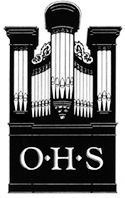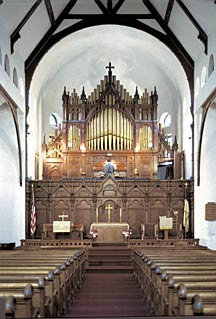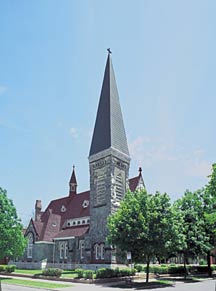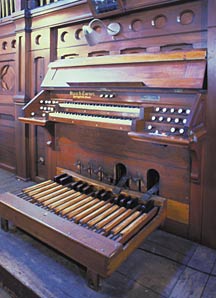Chicago-Midwest ChapterOrgan Historical Society |
 |
|
Pullman Greenstone United Methodist Church
|
|
East 112th Street and South Saint
Lawrence Avenue.
|
|
Chicago,
Illinois
|
 |
| "The Green Stone Church" nickname comes from the hue of the Pennsylvania serpentine limestone of its facade. The town of Pullman, annexed to the city of Chicago in 1897, was developed in the early 1880's by the Pullman Palace Car Company, a manufacturer or railroad cars, for the benefit of company workers. The Reverend George Lane, in Chicago Churches and Synagogues, states: "[the town] was an economic and social experiment, the largest and most complete nineteenth century planned industrial community." Workers rented and lived in apartments, town houses, and other homes around the town. The Company controlled town businesses, school, library, theatre, and hospital. At the heart of the town of Pullman, not far from the factory, was the Hotel Florence (named for Pullman's daughter) and the Church. (Pullman had a two-manual Kimball organ installed in his home on Prairie Avenue in an affluent neighborhood on the near-South Side of Chicago. The instrument was played for the first time at Florence's wedding on April 29, 1896.) The church of Romanesque design was built in 1882 to the plans of the town architect, Solon S. Beman, at a cost of $57,000. (Beman later designed First Church of Christ, Scientist, of Evanston, now owned by the Music Institute of Chicago) Pullman arranged for his brother, Dr. James M. Pullman, a Unitarian minister, to dedicate the edifice. While intended to be a worship center for the Pullman company town (called the Pullman Palace Car Company Church), a church for all denominations, this experiment did not work. George Pullman, founder and president of the Pullman Company, was noted as saying the following about the church, "When the church was built, it was not intended so much for the moral and spiritual welfare of the people as it was for the completion of the artistic effect of the scene." For much of its first quarter-century, the building sat unused as no one congregation could pay the rent required of Pullman. Following a much-publicized antitrust controversy, Pullman was forced to sell off most of the town, beginning in 1898, the year following Pullman's death. In 1907, the church building was sold to the Methodist congregation for $15,000. The entire Pullman neighborhood gained National Historic Landmark status in 1971 and became an official Chicago Landmark in 1972. |
 |
| The mechanical-action organ (2 manuals, 21 stops, 23 ranks) in the church was built by Steere & Turner, Springfield, Massachusetts, in 1882, as their opus 170. Its original cost was $3,500. In 1968, Kurt Roderer, of Evanston, Illinois, renovated the organ. According to Michael Friesen's article in The Stopt Diapason, whole issue 17, volume 3, number 5, October 1982, pages 3-7, the project included "cleaning of all pipework, the replacement of about 12 pipes in all (not due to prior vandalism but simply due to deterioration beyond repair), a rebuilding of the pedalboard, a new blower and tremulant, releathering the bellows, some new tuning sleeves, substitution of aluminum for wooden trackers, some new wood squares and plastic blocks, and overall re-regulation and tuning." In addition, the mixture was somewhat repitched. The organ was presented the Historic Organ Citation by the Organ Historical Society in 1984 (citation #49). |
 |
|
Great (Manual I) 16 Bourdon Treble (from tenor F, wood - 41 pipes) 16 Bourdon Bass (remainder of Bourdon rank, wood - 17 pipes) 8 Open Diapason (metal - 58 pipes) 8 Melodia (first twelve stopped wood, then open wood - 58 pipes) 8 Dulciana (metal - 58 pipes) 4 Octave (metal - 58 pipes) 4 Flute d'Amour (stopped wood and metal - 58 pipes) 2-2/3 Twelfth (label replaced, metal - 58 pipes) 2 Fifteenth (metal - 58 pipes) III Mixture (metal - originally 174 pipes, now repitched with 167 pipes) 8 Trumpet (full-length, conical, slotted, enclosed with Swell, metal - 58 pipes) 8 Clarionet (half-length, tubular resonators, enclosed with Swell, from tenor C, metal - 46 pipes) |
|
Swell (Manual II - Enclosed) 8 Open Diapason (wood and metal - 58 pipes) 8 Stopd. Diapason (wood - 58 pipes) 8 Salicional (metal - 58 pipes) 8 Aeoline (metal - 58 pipes) 4 Violina (metal - 58 pipes) 4 Flute Harmonique (first 24 open wood, metal and harmonic from middle C, wood and metal - 58 pipes) 2 Flautino (metal - 58 pipes) 8 Oboe (full-length, conical, slotted, from tenor C, metal - 46 pipes) 8 Bassoon (full-length, conical, slotted, bottom octave for Oboe, metal - 12 pipes) Tremolo |
Pedal16 Open Diapason (wood - 27 pipes) 16 Bourdon (wood - 27 pipes) |
CouplersI Manual to Pedale Coupler II Manual to Pedale Coupler Manual Coupler (Swell to Great) |
|
Pedal Movements (unlabeled) Piano Great (retires all but Dulciana and Melodia, single acting) Mezzo Great (draws Open, Dulciana, Melodia, 4' Flute, 2', double acting) Forte Great (draws Mezzo stops, plus Octave, 2-2/3', Mixture, Clarionet) Piano Swell (retires all but Salicional and Aeoline, single acting) Forte Swell (draws all Swell stops) I Manuale to Pedale Reversible |
Accessories2 balanced Swell pedals both operating the same mechanism Bellows Signal |
|
Mixture Composition (from Wyly, The Diapason, September 1968, page 30) C-b 2'-2'-1-1/3'-1' c1-b1 2-2/3'-2'-1-1/3' c2-a3 4'-2-2/3'-2' |
| Information for this article was gathered from The Organ Handbook: 1984, published by the Organ Historical Society, Richmond, Virginia, 1984, pages 74-75; "The 100th Anniversary of the Pullman Steere & Turner Organ," The Stopt Diapason, Michael D. Friesen, whole issue 17, volume 3, number 5, October 1982, pages 3-7, whole issue 30, volume 5, number 6, December 1984, page 14, whole issue 53, Autumn 1996, pages 6-7; The Diapason, September 1968, pages 30-31, October 1968, pages 24-25; Chicago Churches and Synagogues: An Architectural Pilgrimage, the Reverend George A. Lane, sj, Loyola University Press, Chicago, Illinois, 1981, page 44; The History of the Organ in the United States, Orpha Ochse, Indiana University Press, Bloomington, Indiana, 1988, pages 241-242; The Tracker, volume 10, number 4, Summer 1966, pages 4-5. |